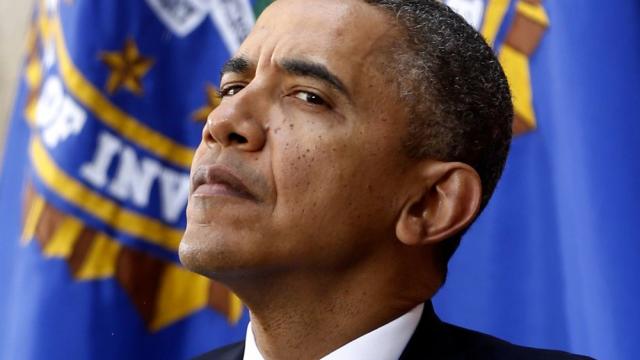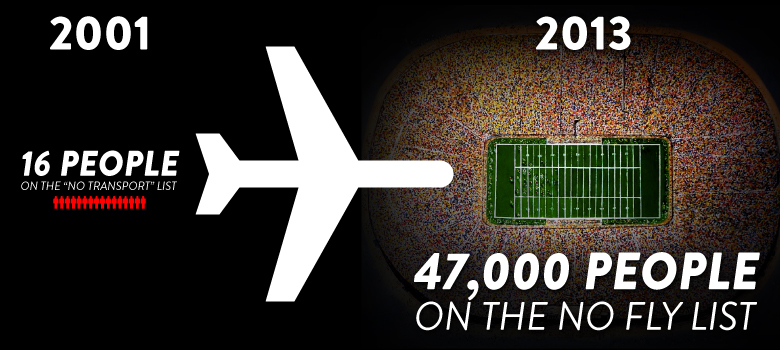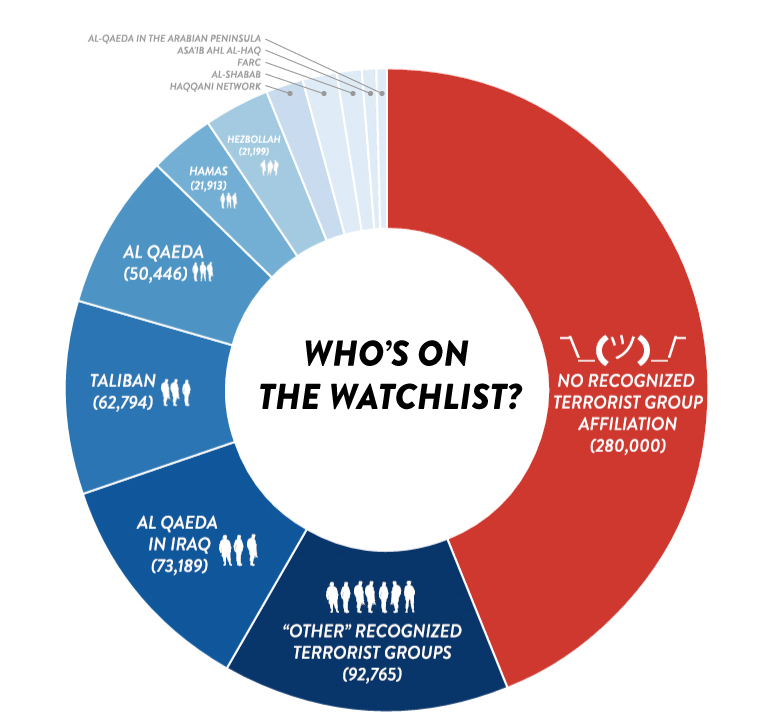
Nearly half of the people on the U.S. government’s widely shared database of terrorist suspects are not connected to any known terrorist group, according to classified government documents obtained by The Intercept.
Of the 680,000 people caught up in the government’s Terrorist Screening Database—a watchlist of “known or suspected terrorists” that is shared with local law enforcement agencies, private contractors, and foreign governments—more than 40 percent are described by the government as having “no recognized terrorist group affiliation.” That category—280,000 people—dwarfs the number of watchlisted people suspected of ties to al Qaeda, Hamas, and Hezbollah combined.
The documents, obtained from a source in the intelligence community, also reveal that the Obama Administration has presided over an unprecedented expansion of the terrorist screening system. Since taking office, Obama has boosted the number of people on the no fly list more than ten-fold, to an all-time high of 47,000—surpassing the number of people barred from flying under George W. Bush.
“If everything is terrorism, then nothing is terrorism,” says David Gomez, a former senior FBI special agent. The watchlisting system, he adds, is “revving out of control.”
The classified documents were prepared by the National Counterterrorism Center, the lead agency for tracking individuals with suspected links to international terrorism. Stamped “SECRET” and “NOFORN” (indicating they are not to be shared with foreign governments), they offer the most complete numerical picture of the watchlisting system to date. Among the revelations:
• The second-highest concentration of people designated as “known or suspected terrorists” by the government is in Dearborn, Mich.—a city of 96,000 that has the largest percentage of Arab-American residents in the country.
• The government adds names to its databases, or adds information on existing subjects, at a rate of 900 records each day.
• The CIA uses a previously unknown program, code-named Hydra, to secretly access databases maintained by foreign countries and extract data to add to the watchlists.
A U.S. counterterrorism official familiar with watchlisting data told The Intercept that as of November 2013, there were approximately 700,000 people in the Terrorist Screening Database, or TSDB, but declined to provide the current numbers. Last month, the Associated Press, citing federal court filings by government lawyers, reported that there have been 1.5 million names added to the watchlist over the past five years. The government official told The Intercept that was a misinterpretation of the data. “The list has grown somewhat since that time, but is nowhere near the 1.5 million figure cited in recent news reports,” he said. He added that the statistics cited by the Associated Press do not just include nominations of individuals, but also bits of intelligence or biographical information obtained on watchlisted persons.
When U.S. officials refer to “the watchlist,” they typically mean the TSDB, an unclassified pool of information shared across the intelligence community and the military, as well as local law enforcement, foreign governments, and private contractors. According to the government’s watchlisting guidelines, published by The Intercept last month, officials don’t need “concrete facts” or “irrefutable evidence” to secretly place someone on the list—only a vague and elastic standard of “reasonable suspicion.”
“You need some fact-basis to say a guy is a terrorist, that you know to a probable-cause standard that he is a terrorist,” says Gomez, the former FBI agent. “Then I say, ‘Build as big a file as you can on him.’ But if you just suspect that somebody is a terrorist? Not so much.”
The National Counterterrorism Center did not respond to questions about its terrorist screening system. Instead, in a statement, it praised the watchlisting system as a “critical layer in our counterrorism defenses” and described it as superior to the pre-9/11 process for tracking threats, which relied on lists that were “typed or hand-written in card catalogues and ledgers.” The White House declined to comment.
A Milestone
Most people placed on the government’s watchlist begin in a larger, classified system known as the Terrorist Identities Datamart Environment (TIDE). The TIDE database actually allows for targeting people based on far less evidence than the already lax standards used for placing people on the watchlist. A more expansive—and invasive—database, TIDE’s information is shared across the U.S. intelligence community, as well as with commando units from the Special Operations Command and with domestic agencies such as the New York City Police Department.
In the summer of 2013, officials celebrated what one classified document prepared by the National Counterterrorism Center refers to as “a milestone”—boosting the number of people in the TIDE database to a total of one million, up from half a million four years earlier.
The document credits that historic achievement to the Directorate of Terrorist Identities (DTI), a secretive and virtually unknown U.S. counterterrorism unit responsible for maintaining TIDE. “This number is a testament to DTI’s hard work and dedication over the past 2.5 years,” the document declares.
The number is also a testament to the Obama administration’s intensified collection of personal information on individuals with suspected links to terrorism. In 2006, CBS News obtained a copy of the no fly list and reported that it included 44,000 names, including Bolivian President Evo Morales and the head of Lebanon’s parliament. Faced with a widespread public backlash, the government cut the list down to just 4,000 names by late 2009.
The next year, after the so-called “underwear bomber” tried to bring down a commercial airliner bound for Detroit, Obama loosened the criteria for adding people to the no fly list. The impact was immediate. Since 2010, the classified documents note, the National Counterterrorism Center has “created more than 430,000 terrorism-related person records” while deleting only 50,000 people “whose nexus to terrorism was refuted or did not meet current watchlisting criteria.” The documents reveal that more than 240 TIDE “nominations” are now processed each day.
“You might as well have a blue wand and just pretend there’s magic in it, because that’s what we’re doing with this—pretending that it works,” says former FBI agent Michael German, now a fellow at New York University’s Brennan Center for Justice. “These agencies see terrorism as a winning card for them. They get more resources. They know that they can wave that card around and the American public will be very afraid and Congress and the courts will allow them to get away with whatever they’re doing under the national security umbrella.”
Watchlisting by the Numbers
In the documents, the government emphasizes that it seeks to add only as many people to the TIDE list “as are necessary for our nation’s counterterrorism mission.” With hundreds of new nominations coming in every day, the numbers provide only a momentary snapshot of a watchlist system that is in constant motion.
An August 2013 slide from the National Counterterrorism Center called “TIDE By The Numbers” lays out the scope of the Obama administration’s watchlisting system, and those it is targeting. According to the document, which notes that the numbers are “approximate,” 680,000 people have been watchlisted, with another 320,000 monitored in the larger TIDE database. As of August 2013, 5,000 Americans were on the watchlist while another 15,800 were targeted in TIDE.
Among the other revelations in the documents:
• 16,000 people, including 1,200 Americans, have been classified as “selectees” who are targeted for enhanced screenings at airports and border crossings.
• There are 611,000 men on the main terrorist watchlist and 39,000 women.
• The top “nominating agencies” responsible for placing people on the government’s watchlists are: the Central Intelligence Agency, the Defense Intelligence Agency, the National Security Agency, and the Federal Bureau of Investigation.
• The top five U.S. cities represented on the main watchlist for “known or suspected terrorists” are New York; Dearborn, Mich.; Houston; San Diego; and Chicago. At 96,000 residents, Dearborn is much smaller than the other cities in the top five, suggesting that its significant Muslim population—40 percent of its population is of Arab descent, according to the U.S. Census Bureau—has been disproportionately targeted for watchlisting. Residents and civil liberties advocates havefrequently argued the Muslim, Arab and Sikh communities in and around Dearborn are unfairly targeted by invasive law enforcement probes, unlawful profiling, and racism.
“To my knowledge, there have been no Muslims in Dearborn who have committed acts of terrorism against our country,” Dawud Walid, executive director of the Michigan chapter of the Council on American-Islamic Relations, told The Intercept. Walid added that the high concentration of Dearborn residents in the watchlisting system “just confirms the type of engagement the government has with our community—as seeing us as perpetual suspects.”
The documents also offer a glimpse into which groups the government is targeting in its counterterrorism mission. The groups with the largest number of targeted people on the main terrorism watchlist—aside from “no recognized terrorist group affiliation”—are al Qaeda in Iraq (73,189), the Taliban (62,794), and al Qaeda (50,446). Those are followed by Hamas (21,913) and Hezbollah (21,199).
Although the Obama administration has repeatedly asserted that al Qaeda in the Arabian Peninsula poses the most significant external terrorist threat to the United States, the 8,211 people identified as being tied to the group actually represent the smallest category on the list of the top ten recognized terrorist organizations. AQAP is outnumbered by people suspected of ties to the Pakistan-based Haqqani Network (12,491), the Colombia-based FARC (11,275,) and the Somalia-based al-Shabab (11,547).
The documents also reveal that as of last year, the U.S. had designated 3,200 people as “known or suspected terrorists” associated with the war in Syria. Among them were 715 Europeans and Canadians, as well as 41 Americans. Matt Olsen, the director of the National Counterterrorism Center, recently claimed that there are more than 12,000 foreign fighters in Syria, including more than 1,000 Westerners and roughly 100 Americans.
Biometric Data
According to the documents, the government does much more than simply stop watchlisted people at airports. It also covertly collects and analyzes a wide range of personal information about those individuals –including facial images, fingerprints, and iris scans.
In the aftermath of last year’s Boston Marathon bombing, the Directorate of Terrorist Identities began an aggressive program to collect biometric data and other information on all Americans on the TIDE list. “This project includes record by record research of each person in relevant Department of State and [intelligence community] databases, as well as bulk data requests for information,” the documents note.
The DTI also worked on the subsequent Chicago Marathon, performing “deep dives” for biometric and other data on people in the Midwest whose names were on the TIDE list. In the process, the directorate pulled the TIDE records of every person with an Illinois, Indiana, or Wisconsin driver license.
DTI’s efforts in Boston and Chicago are part of a broader push to obtain biometric information on the more than one million people targeted in its secret database. This includes hundreds of thousands of people who are not watchlisted. In 2013, the directorate’s Biometric Analysis Branch (BAB) launched an initiative to obtain biometric data from driver’s license records across the country. At least 15 states and the District of Columbia are working with the directorate to facilitate access to facial images from driver’s licenses. In fiscal year 2013, 2,400 such images were provided for inclusion in the secret TIDE database.
According to the documents, BAB offers its “unique skill of facial identification support” to a “broad customer base.” Last year its analysts produced more than 290 reports for other government entities, including the CIA, the New York City Police Department, and the military’s elite Special Operations Command.
All told, the classified documents show, the government compiles strikingly detailed dossiers of data on individuals who have been swept up in its databases. Though some of the documents obtained by The Intercept offer conflicting information on how much biometric data the government collects,the most detailed report shows that:
• In 2013, the main terrorism database included more than 860,000 biometric files on 144,000 people.
• The database contains more than a half a million facial images, nearly a quarter of a million fingerprints and 70,000 iris scans.
• The government maintains biometric data on people that it hasn’t identified–TIDE contains 1,800 “BUPs,” or “biometrics of unknown persons.”
• In a single year, the government expanded its collection of “non-traditional” biometric data, including dramatic increases in handwriting samples (32 percent), signatures (52 percent), scars, marks, and tattoos (70 percent), and DNA strands (90 percent).
“We’re getting into Minority Report territory when being friends with the wrong person can mean the government puts you in a database and adds DMV photos, iris scans, and face recognition technology to track you secretly and without your knowledge,” says Hina Shamsi, director of the American Civil Liberties Union’s National Security Project. “The fact that this information can be shared with agencies from the CIA to the NYPD, which are not known for protecting civil liberties, brings us closer to an invasive and rights-violating government surveillance society at home and abroad.”
The DTI also goes far beyond accessing information from state driver’s licenses. In managing the main terrorism database, the directorate coordinates with the CIA and the National Media Exploitation Center, a Pentagon wing responsible for analyzing and disseminating “paper documents, electronic media, videotapes, audiotapes, and electronic equipment” seized abroad in military or intelligence operations.
By sharing information with the military, the National Counterterrorism Center asserts, the DTI is able to “obtain additional data fusion points by accessing and exploiting NMEC data holdings.” In return, the directorate “provides NMEC with a classified biometric search capability against TIDE through automated and manual facial identification support.”
The DTI also harvests information from CIA sources, including a secret database called CINEMA— short for CIA Information Needs Management—and a secret CIA program called “Hydra,” which utilizes “clandestinely acquired foreign government information” to enhance the quality of “select populations” in TIDE.
In 2013, DTI and the CIA ran a “proof of concept” for Hydra, using Pakistan as a guinea pig. The DTI provided the CIA with a list of 555 Pakistanis in the TIDE database. After inputting the names into Hydra, the CIA “vetted these names against Pakistani Passports” and provided biographic and biometric identifiers to the DTI.
Pleased with its initial success, the government plans to expand its clandestine data-mining operation. “Future initiatives,” the documents note, “will include additional targeted countries.” The CIA declined to comment on the program.
Josh Begley contributed to this story.
3 WAYS TO SHOW YOUR SUPPORT
- Log in to post comments















